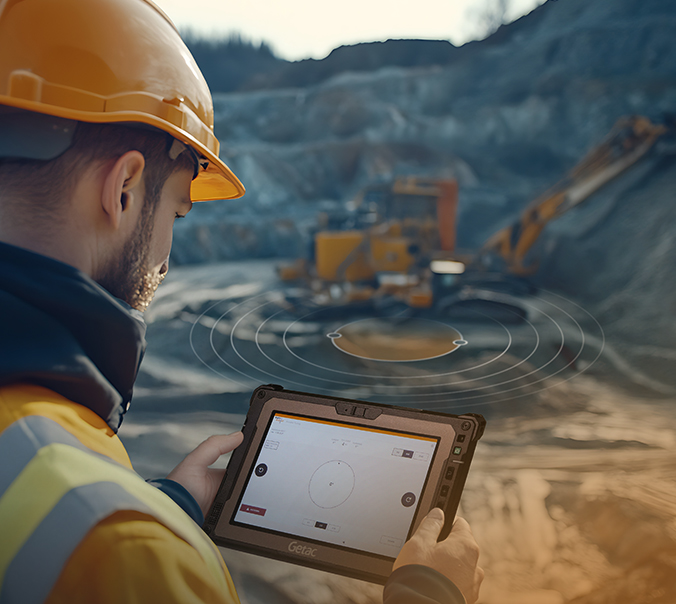News
Elimination of Live Work in Mining
August 15, 2025
Blogs
Wireless Hydraulic Maintenance Helping Set New Safety Benchmarks
Hydraulic maintenance has long required technicians to perform live work in mining, often close to operating machinery, in heat, under pressure and near moving components. Live work refers to any work on plant, equipment or system where the energy cannot be fully isolated in a practical manner, posing risk or injury due to uncontrolled energy within the hazard exposure zone. These conditions increase the risk of serious incidents like high-pressure fluid injection, equipment failures and impact injuries due to unexpected releases of stored energy.
To address these risks, the mining industry is steadily moving toward Elimination of Live Work in mining (ELW). The idea is straightforward. You take people out of situations where they could be exposed to hazards if something goes wrong. The ELW movement is having a significant impact on hydraulic maintenance, and addressing related risks has become a priority for mining operations. It’s changing the way machines are built, the way maintenance is scheduled and the way safety is measured on site.

Why Eliminating Live Work Matters
The most obvious driver for ELW is safety. Working in the “footprint” of live machinery exposes technicians to hazards such as: High-pressure fluid release causes injection injuries or burns.
Unexpected machine movement during testing or adjustment.
Stored energy is released from accumulators, springs, or elevated loads.
Trips and falls caused by restricted access in tight machinery zones.
Each of these hazards can potentially cause life-altering injuries. Eliminating live work removes the need for technicians to be in proximity, radically improving safety. According to Safe Work Australia’s guidelines on managing the risks of plant in the workplace, eliminating live work is considered one of the most effective controls for reducing hazardous energy exposure.
But ELW is also about productivity and reliability. Reducing the risk of incidents helps avoid unplanned shutdowns, lost time and costly investigations. Remote-capable maintenance tools also allow work to be completed faster, reducing downtime and getting machines back to production sooner.
What’s Making ELW in Mining Possible Now
For years, the main barrier to the elimination of live work in mining was the lack of reliable technology that could replace hands-on adjustments without sacrificing precision. Hydraulic tuning, for example, has traditionally required physical access to pressure relief valves or control settings, often located deep inside a machine’s structure.
That is changing. Advances in wireless control, ruggedised digital interfaces, and compact actuators are making it possible to achieve the same, or even better results without entering hazardous zones. Industry leaders are now incorporating ELW principles into new equipment design, while maintenance teams are retrofitting existing fleets with safer, remote-enabled solutions.
At the same time, cultural change is taking place. Mining safety managers, operations teams and frontline technicians are increasingly aligned in recognising that “the way it’s always been done” is no longer acceptable when other alternatives exist, prioritising safety over productivity.
What Eliminating Live Work Looks Like in Practice
Putting ELW into practice means rethinking how maintenance is carried out so crews can complete tasks without entering high-risk areas. In hydraulic systems, that could mean moving pressure adjustments to accessible locations, integrating sensors that provide live diagnostics from outside the machine footprint or using remote and wireless tools to handle tuning and calibration.
Redesigning the process in this way keeps people out of danger and creates a smoother, more efficient workflow that reduces delays and unnecessary steps. When technicians can see precise data in real time and make adjustments from a safe position, they spend less time navigating tight spaces or working around moving parts. When done correctly, operations will experience more uptime, faster turnaround on maintenance, fewer unplanned stoppages, and all while meeting higher safety standards.
How SafeAdjust Supports the Elimination of Live Work in Mining
Eliminating live work is not about simply adding a single piece of equipment. It’s about applying a layer of controls that include design improvements, engineering barriers, robust procedures and user-centred technology. By eliminating the need for manual adjustments in hazardous conditions, SafeAdjust prioritises operator safety without compromising system performance.
HydraTune’s SafeAdjust puts the controls where they should be: in the hands of the technician, outside of the danger zone. Using a rugged industrial tablet, teams can make precise adjustments from a safe distance (up to 100m away) while seeing every change in real time. The high-fidelity Bluetooth connection stays stable even in remote or dusty sites, and over-the-air updates keep the system performing at its best without taking equipment offline.
Because SafeAdjust integrates with existing isolation procedures and barriers, it complements, not replaces, other risk management measures. With SafeAdjust, you keep your technicians out of harm’s way and provide them with the comprehensive data they need to perform thorough verification and planning.
Eliminate Live Work in Mining with HydraTune
The elimination of live work in mining presents challenges, but the tools to achieve it already exist. SafeAdjust is one example of how remote, field-ready digital technology can reduce exposure, improve data quality, and support safer, smarter maintenance practices. Sites that still depend on manual tuning in hazardous zones have a clear opportunity to move toward safer operations and stronger maintenance performance.
